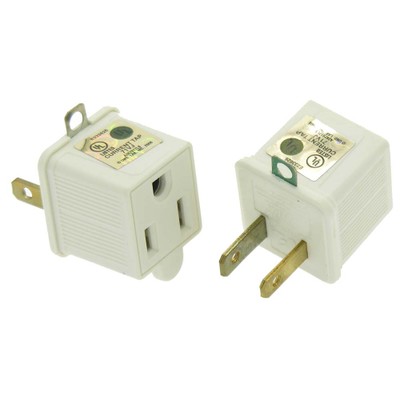
+- MacResource (https://forums.macresource.com)
+-- Forum: My Category (https://forums.macresource.com/forumdisplay.php?fid=1)
+--- Forum: Tips and Deals (https://forums.macresource.com/forumdisplay.php?fid=3)
+--- Thread: Can anyone here ID this old outlet? (/showthread.php?tid=246100)
Re: Can anyone here ID this old outlet? - testcase - 09-09-2020
I expect that outlet goes back to the 1920s (if not older). It's also labeled as "250V". Back in the "early days" before standards were set, local electric companies were free to set whatever standards worked best for their systems. Today, those "T" slots would signify a 20A rating (meaning 12ga wires were required).
Re: Can anyone here ID this old outlet? - MrNoBody - 09-09-2020
a house fire waiting to happen?
Re: Can anyone here ID this old outlet? - deckeda - 09-09-2020
Hubbel basically invented the modern style, didn’t they? Although by the time this one was made they had competition.
Some appliances will not like it if the polarity is backwards. Things with microprocessors like modern coffee pots and whatever can yield “surprising” results of not designed to ignore it.
There’s a slim chance that the box and plate are grounded, however. But really, any outlet and associated wiring that old that still works is an accomplishment.
Re: Can anyone here ID this old outlet? - bazookaman - 09-09-2020

Re: Can anyone here ID this old outlet? - chopper - 09-09-2020
Thank you, testcase. House was built in 1920. I guess I will call an electrician.
Re: Can anyone here ID this old outlet? - macphanatic - 09-09-2020
Have you used a volt meter to confirm that it's on a 110/120 volt circuit? The current/voltage ratings on the front most likely only indicate the maximum rated usage for each.
The plug appears to be nondirectional - plug can be inserted in either direction. I wonder if it was intended to power different items at different voltages. Example, plug a standard plug that we use today at 110/120 volt. A different plug might actually connect at 220/240 volt. If you could shine a light into the outlet to see the connections inside, it might reveal more.
Re: Can anyone here ID this old outlet? - davester - 09-09-2020
Polarized plugs and outlets didn't appear until sometime in the 1980s. There are many simple devices (e.g. lamps, etc) that don't use plarized plugs.
Re: Can anyone here ID this old outlet? - N-OS X-tasy! - 09-09-2020
davester wrote:
Polarized plugs and outlets didn't appear until sometime in the 1980s. There are many simple devices (e.g. lamps, etc) that don't use plarized plugs.
As well as simple adapters that enable the use of polarized plugs with non-polarized outlets: https://www.cablewholesale.com/specs/30w1-32000.php?utm_source=GoogleShopping&utm_medium=cpc&utm_term=30W1-32000&utm_campaign=3%20Prong%20to%202%20Prong%20Grounding%20Converter%20for%20AC%20Outlet%2C%202-pack&gclid=EAIaIQobChMIkrrb-Ozc6wIVBBx9Ch3ABgLREAQYCyABEgJMv_D_BwE
Re: Can anyone here ID this old outlet? - GGD - 09-09-2020
N-OS X-tasy! wrote:
[quote=davester]
Polarized plugs and outlets didn't appear until sometime in the 1980s. There are many simple devices (e.g. lamps, etc) that don't use plarized plugs.
As well as simple adapters that enable the use of polarized plugs with non-polarized outlets: https://www.cablewholesale.com/specs/30w1-32000.php?utm_source=GoogleShopping&utm_medium=cpc&utm_term=30W1-32000&utm_campaign=3%20Prong%20to%202%20Prong%20Grounding%20Converter%20for%20AC%20Outlet%2C%202-pack&gclid=EAIaIQobChMIkrrb-Ozc6wIVBBx9Ch3ABgLREAQYCyABEgJMv_D_BwE
From the picture, itt still looks like that will only plug into a polarized two prong outlet, one prong looks larger than the other.

Re: Can anyone here ID this old outlet? - macphanatic - 09-09-2020
GGD wrote:
[quote=N-OS X-tasy!]
[quote=davester]
Polarized plugs and outlets didn't appear until sometime in the 1980s. There are many simple devices (e.g. lamps, etc) that don't use plarized plugs.
As well as simple adapters that enable the use of polarized plugs with non-polarized outlets: https://www.cablewholesale.com/specs/30w1-32000.php?utm_source=GoogleShopping&utm_medium=cpc&utm_term=30W1-32000&utm_campaign=3%20Prong%20to%202%20Prong%20Grounding%20Converter%20for%20AC%20Outlet%2C%202-pack&gclid=EAIaIQobChMIkrrb-Ozc6wIVBBx9Ch3ABgLREAQYCyABEgJMv_D_BwE
From the picture, itt still looks like that will only plug into a polarized two prong outlet, one prong looks larger than the other.

It has to be in order to be UL listed. The green loop is to be secured to the outlet using the cover plate screw. The older versions had thinner "wings" top and bottom of the neutral blade. Some people used to use diagonals to trim them to make them nondirectional.